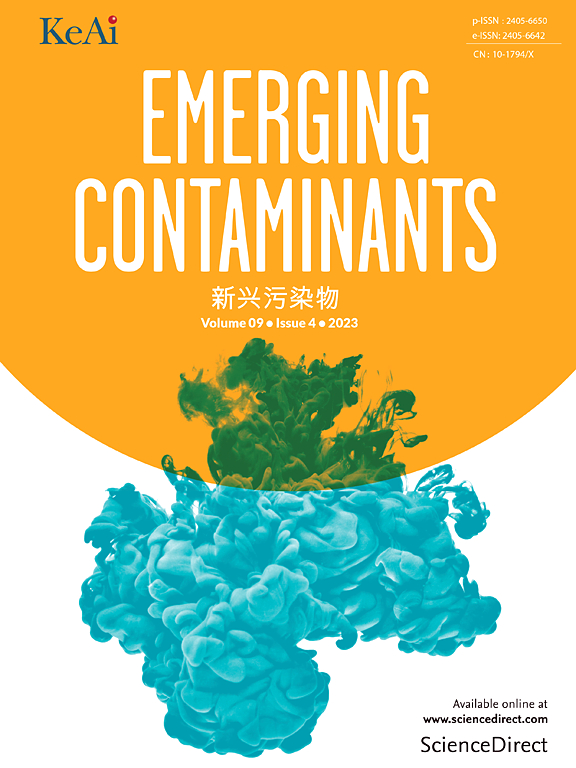Challenges and persistence of contact lenses in wastewater treatment plants: Environmental implications
IF 6.9
2区 环境科学与生态学
Q1 ENVIRONMENTAL SCIENCES
引用次数: 0
Abstract
Contact Lens (CLs) are often disposed of via toilet or sinks, ending up in the wastewater treatment plants (WWTPs). Millions of CLs enter WWTPs worldwide each year in macro and micro sizes. Despite WWTPs' ability to remove solids, CLs can persist and potentially contaminate watercourses and soils.
This study evaluates whether different CLs degrade in WWTP aeration tanks. Six daily CLs (Nelfilcon A, Delefilcon A, Nesofilcon A, Stenfilcon A, Narafilcon A, Somofilcon A) and four monthly CLs (Lotrafilcon B, Comfilcon A, Senofilcon A, and Samfilcon A) were immersed in aeration tanks for twelve weeks. Their physical and chemical properties, including water content (WC), refractive index (RI), chemical properties (Fourier Transform Infrared Spectroscopy), and mechanical properties were assessed.
Results show that all CLs maintained their physical appearance after 12 weeks. Neither Nelfilcon A nor Narafilcon A exhibited significant changes in WC and RI, (p > 0.05, Tukey test), while other daily lenses showed variations in at least one parameter.
Among monthly CLs, only Senofilcon A showed significant differences in both WC (p < 0.001, Tukey test) and RI (p < 0.0001, Tukey test). No differences in Young's modulus were observed for any lenses (p > 0.05 Tukey test). However, Somofilcon A displayed significant changes in stress at break (p < 0.0001, Tukey test), and Elongation at Break (p < 0.05, Tukey test). No changes were found in the chemical structure of any CLs suggesting that twelve weeks in WWTP aeration tanks is insufficient for CLs degradation. These findings highlight CLs as a potential emerging pollutant, emphasizing their persistence in sludge or migration into watercourses and soils.

隐形眼镜在污水处理厂的挑战和持久性:环境影响
隐形眼镜(CLs)通常通过厕所或水槽处理,最终进入污水处理厂(WWTPs)。全球每年有数百万的CLs以宏观和微观的方式进入WWTPs。尽管污水处理机具有去除固体的能力,但CLs可能会持续存在,并可能污染水道和土壤。本研究评价了不同氯化氯在污水处理厂曝气池中的降解情况。将6个日型超滤细胞(Nelfilcon A、delfilcon A、nesfilcon A、Stenfilcon A、Narafilcon A、somfilcon A)和4个月型超滤细胞(Lotrafilcon B、Comfilcon A、senfilcon A和Samfilcon A)浸泡在曝气池中12周。评估了它们的物理和化学性质,包括含水量(WC)、折射率(RI)、化学性质(傅立叶变换红外光谱)和力学性能。结果显示,所有CLs在12周后保持其物理外观。Nelfilcon A和Narafilcon A均未表现出WC和RI的显著变化(p >;0.05, Tukey检验),而其他日常镜头显示至少一个参数的变化。在月度CLs中,只有Senofilcon A在两种WC (p <;0.001, Tukey检验)和RI (p <;0.0001, Tukey检验)。任何透镜的杨氏模量均无差异(p >;0.05 Tukey检验)。然而,Somofilcon A在断裂时表现出显著的应力变化(p <;0.0001, Tukey检验),断裂伸长率(p <;0.05, Tukey检验)。在化学结构上没有发现任何CLs的变化,这表明在污水处理厂曝气池中12周的时间不足以降解CLs。这些发现突出了氯化氯作为一种潜在的新兴污染物,强调了它们在污泥中持续存在或迁移到水道和土壤中。
本文章由计算机程序翻译,如有差异,请以英文原文为准。
求助全文
约1分钟内获得全文
求助全文
来源期刊

Emerging Contaminants
Medicine-Public Health, Environmental and Occupational Health
CiteScore
10.00
自引率
6.70%
发文量
35
审稿时长
44 days
期刊介绍:
Emerging Contaminants is an outlet for world-leading research addressing problems associated with environmental contamination caused by emerging contaminants and their solutions. Emerging contaminants are defined as chemicals that are not currently (or have been only recently) regulated and about which there exist concerns regarding their impact on human or ecological health. Examples of emerging contaminants include disinfection by-products, pharmaceutical and personal care products, persistent organic chemicals, and mercury etc. as well as their degradation products. We encourage papers addressing science that facilitates greater understanding of the nature, extent, and impacts of the presence of emerging contaminants in the environment; technology that exploits original principles to reduce and control their environmental presence; as well as the development, implementation and efficacy of national and international policies to protect human health and the environment from emerging contaminants.
 求助内容:
求助内容: 应助结果提醒方式:
应助结果提醒方式:


